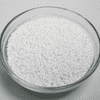
Sodium benzoate
High risk
Alternate Names:
- benzenecarboxylic acid sodium salt
- benzoate of soda
- benzoic acid sodium salt
- dracylic acid sodium salt
- phenylcarboxylic acid sodium salt
- sodium benzoate
Info from food-info.net:
- Description:
- Function:
- Benzoic acid and benzoates are used as preservatives against both yeasts and bacteria in acidic products. They are not very effective against fungi, and ineffective in products with a pH above 5 (slightly acidic or neutral). High concentrations have an acid taste, which limits the application. Benzoates are often preferred, due to better solubility.
- Origin:
- Benzoic acid, benzoates and benzoic acid esters are commonly found in most fruits, especially berries. Cranberries are a very rich source of benzoic acid. In addition to fruits, benzoates occur naturally in mushrooms, cinnamon, cloves and some dairy products (as a result of bacterial fermentation). For commercial purposes, it is prepared chemically from toluene.
- Side effects:
- No side effects in the concentrations used. In some people benzoic acid and benzoates may liberate histamine and thus cause pseudo-allergic reactions.
Dietary restrictions:- None - benzoic acid and benzoates can be consumed by all religious groups, vegans and vegetarians.
Acceptable daily intake:- Up to 5 mg/kg body weight.
Status:- Unknown
Info from proe.info:
- Description:
- Benefits:
- Unknown
- General:
- Sodium benzoate (the food additive E211) is benzoic acid compound, which is present in nature in low concentration in such products as prune, cranberry, cinnamon, cloves and apples. Sodium benzoate is a resultant of benzoic acid neutralization by sodium hydroxide. Due to good solubility in water, sodium benzoate is used as a food additive more often in comparison with benzoic acid (the additive E210), which offers not only the stronger preservative properties, but also the low level of solubility at the same time. As for the external appearance, the additive E211 is a white powdery substance without any smell or having slight smell of benzaldehyde. The chemical formula of sodium benzoate is NaC6H5CO2. The food additive E211 has a suppressive effect on activity level of enzymes in microbial cells, which are responsible for lipolysis, amylolysis and a course of redox reactions. Besides, sodium benzoate is able to produce strong suppressive effect on rain crops, mycelial and aflatoxin fungus as well. Owing to its properties, the additive E211 is used as a preservative in the food industry. Coming into reaction with ascorbic acid (vitamin C, the additive E300), sodium benzoate can form benzol, which is a potent carcinogen. According to the data from the research of Peter Piper, British scientist and the professor of Sheffield University, such compound can cause a suppressive DNA damage in mitochondria. Consequently, a range of serious diseases can be provoked, such as neurodegenerative diseases, cirrhosis, Parkinson's Disease etc. The issue of the effect of the additive E211 on the hyperactivity of children is seriously discussed. In 2007, Food Standards Agency of Great Britain carried out the research in this field. Nowadays a number of foreign food companies is seeking for the alternative substitution of the additive E211. Moreover, the additive E211 can cause the aggravation of diseases and allergic reaction in humans, who have supersensitive skin and suffer from urticarial or asthma. As has been already mentioned, sodium benzoate is registered as the food additive E211 in Europe and in the world and is widely used in food industry as a preservative and color enhancer for meat and fish products, sweet carbonated beverages, ketchups, margarines, fruit goods, soy sauces, mayonnaise and dainties, containing mayonnaise, preserves and others. The food additive E211 most frequently occurs in such products as mayonnaise, ketchup, margarine, jam, confectionery, canned fish and caviar, marmalade, fruit butter, non-alcoholic beer and alcoholic drinks with alcohol content fifteen percent and less for 200 mg/l, soft drinks and meat products. Due to its antibacterial properties, sodium benzoate can be applied in pharmaceutical industry and in production of such cosmetics and toiletry goods as shampoos, gels, toothpastes. It is also used in aircraft industry for protection of galvanic coating and aluminum components. Sodium benzoate can be also applied in fireworks for getting a sound effect. The food additive E211 is allowed for use in Russia, Ukraine and many other countries, but during last years the usage of the preservative E211 is lowered because of its insecurity for human health.
- Harm:
- Unknown
- Legal:
- Unknown
- Use:
- Unknown
- Links:
- Unknown
Dietary restrictions:- Unknown
Acceptable daily intake:- Unknown
Status:- Unknown
ninamvseeno.org -- site no longer live
- Description:
- Sodium benzoate is used as a food preservative and to mask the taste of inferior food. It is antibacterial and antifungal in slightly acidic environments and is also used as a disinfectant. It is used as fuel in pyrotechnics. Recommended daily intake: 5mg/kg (including benzoic acids and benzoates). It is found in soft drinks (also flavored water). Various orange juices contain large amounts of the additive (up to 25 mg in 250 ml). It is also used in dairy and meat products, spices, fragrances and sweets. Recent studies have shown that sodium benzoate can deactivate parts of DNA. It is also linked to liver damage and Parkinson's disease. In combination with vitamin C (e300, a potentially carcinogenic substance (benzene) can be formed. One of the studies also proved that E211 is one of the six substances that cause ADHD hyperactivity. It is not recommended for children and people who suffer from asthma or are hypersensitive to aspirin or suffer from skin diseases (urticaria), as allergic reactions and rashes (hives) may occur. Aggravation of the disease state can occur especially when benzoic acid is taken in combination with tartrazine (E102).
Dietary restrictions:- Unknown
Acceptable daily intake:- 5,000 mg/kg body weight/day (EFSA, 2016)
Status:- Approved in the EU.
References: